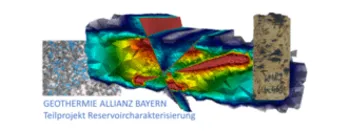Geothermal Alliance Bavaria (GAB-1)
Subproject "Characterization of reservoirs"Subproject "PetroTherm"
Subproject "Operational safety for the thermal water cycle"
Subproject "Monitoring"
Subproject "Efficient and flexible power plants"
Beside these subprojects, publicly supported projects are integrated into the GAB. The network between these associated projects is carried out at the TUM MSE in organized workshops and symposia
The Chair of Hydrogeology is the leader of the subproject “Characterization of reservoirs”.
In this project systematic investigation of local and regional variations with regard to geophysical, geomechanical, geostructural and hydraulic properties take place. The Targets for this project are:
Minimization of geothermal drilling success risks in the Molasse basin in South Germany
Minimization of uncertainties in reservoir-engineering and in the long-term operation of geothermal energy plants
The Chair of Hydrogeology investigate especially the long-term hydraulic and thermal behavior of the Malm aquifer. For this purpose the Geothermal Alliance Bavaria analyses relevant data from the geothermal sites in the southern molasses basin and participates in borehole logging campaigns and well testing to elevate a set of “best-off” data for the research. Additionally lab experiments for the rock parameter (permeability, porosity, thermal conductivity and capacity) are conducted. These results are integrated in THM-simulations to assess the hydraulic behavior.
Further information: https://www.mse.tum.de/en/geothermal-alliance-bavaria/
Results
uja_faultzones is a Python tool to quickly investigate the hydraulic influence of a fault zone on a geothermal wells flow regime and productivity index for a given set of reservoir properties.
It is especially designed for the Upper Jurassic Aquifer of the Northern Alpine Foreland Basin in Southern Germany. By constructing reduced numerical models for the calculation of pressure curves of pumping tests for a vertical well inside a 70° inclined, 1000m long fault zone surrounded by an porous aquifer of 500 meter thickness based on an calibrated FE model using the Reduced Basis Method, very fast and still very precise simulations are possible. No commercial software or complex FE codes are necessary to quickly calculate and plot the results of artificial pumping test for different fault zone – reservoir setups.
Interested? Just try the open source code: https://github.com/Florian-Konrad/uja_faultzones/
Contributions to SDG
Responsible
Dr. Kai Zosseder; Dipl. Geol. Daniel Bohnsack ; M. Sc. Florian Konrad; M. Sc. Florian Heine
Project duration
2016 - 2019 (first phase)
Related projects
Geothermal Alliance Bavaria (second phase: 2020 -2023)



